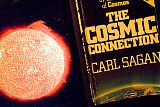
Carl Sagan
The Cosmic Connection
There is something about reading Carl Sagan that is akin to stepping through a time warp. If black holes could cut through time and space, the journey would still be much shorter and simpler to read a book. Occasionally Sagan steps back to the darkness before Creation and its primeval light; occasionally he leaps forward to an unknown future; but mostly he remains in the 1960s and 70s.
In a book about astronomy, the current discoveries and technological advances are important. So an astronomical book 38 years old may have some disadvantages. In Sagan’s time, no exoplanets had been discovered (they were anticipated), but the excitement surrounding the Apollo, Pioneer and Venera voyages was ripe in the air. It is this excitement, for Mars and Venus, for those past discoveries that led to current discoveries, that lends The Cosmic Connection a timelessness despite its age.
And this book asks questions that have still not been answered: “Where are they?” The extraterrestrials, I mean. Carl Sagan was an enthusiastic proponent; he made the search for extraterrestrials acceptable, scientific. And I believe him. The nuclear, chemical, physical, biological accidents that seem geared to life, created life on this planet. There is no reason to be chauvinistic and think that we are the only ones, or the best. In fact, Sagan repeatedly calls humans “backwards” in the most good-humored kind of way.
Our tribal nature, now focused on the invisible lines we have divided into “country” and “nation,” now focused on our perceived differences such as “religion” and “race,” is somewhat humorous and it is preventing our advance as an intelligent civilization. The faster we can communicate, the more information can be communicated, more information is more intelligence. Yet evolution of our species does not keep pace for it seems we still need more than a lifetime to learn that destruction means The End.
It is not a question of whether we are emotionally prepared in the long run to confront a message from the stars. It is whether we can develop a sense that beings with quite different evolutionary histories, beings who may look far different from us, even “monstrous,” may, nevertheless, be worthy of friendship and reverence, brotherhood and trust.
We have trouble accomplishing this feat on Earth: humans, animals, plants, the planet, we are all made from the same star stuff! How shallow of us to overlook this vast and beautiful connection with the universe.
Yet Carl Sagan was not as pessimistic as I about the human race. He imagined our relocation, our continuation after our star dies, he imagined interstellar voyages, trips through black holes and more technology in the future—our present—than we currently can claim. Sagan was a visionary but he also had a healthy dose of skepticism.
The Cosmic Connection came out of the Cold War and was published in the midst of The USA’s War on Communism. The image of a red button implying total Earthly destruction lingers throughout the text. If we are able to see the value of the Earth and humans as a whole, Sagan argues, maybe governments would stop spending so much money on missiles and other vehicles of destruction and peacefully invest some cash in exploring space instead. Maybe.
Humility and reverence are part of the Universal (Multi-versal?) Perspective. If we cannot look beyond ourselves, beyond our momentary suffering and desire, than in a sense, human civilization is hopeless. Luckily we have developed an intelligence which hungers for connection, our curiosity questions, “What more?”
We realize our deep connectedness with other life forms, both simple and complex. We know that the atoms that make us up were synthesized in the interiors of previous generations of dying stars. We are aware of our deep connection, both in form and in matter, with the rest of the universe.
Who knows what answers the future will bring…
· · · · · · · · · · · · · · · · · · · ·